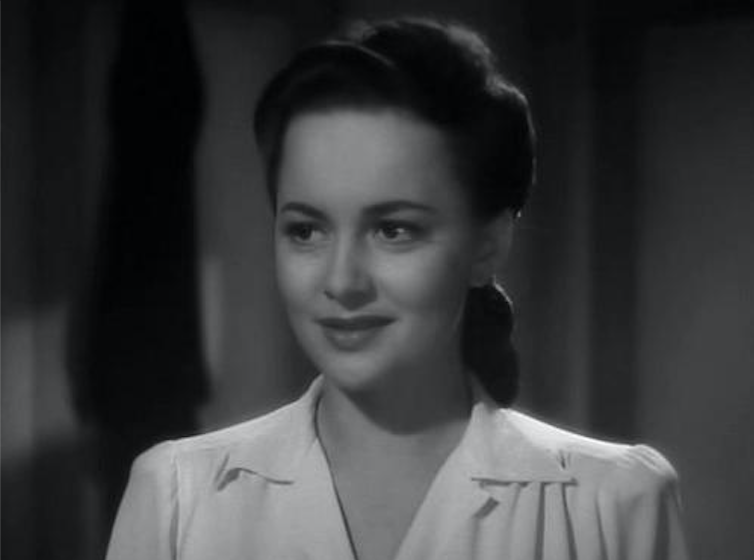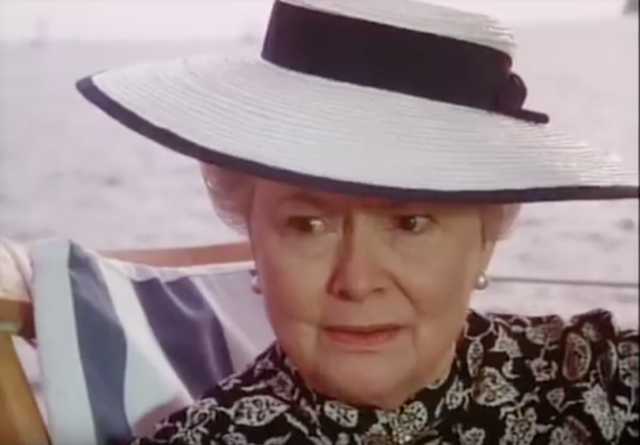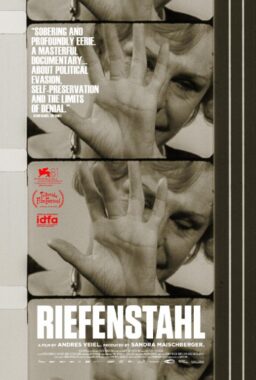Olivia de Havilland turned 104 on July 1 of this year, and she took pleasure in her remarkable longevity. Errol Flynn, her co-star in many beloved adventure films of the 1930s like “The Adventures of Robin Hood” (1938), died over 60 years ago, but of course he was less concerned with endurance than she was. De Havilland was the last surviving star of the classic Hollywood period of the 1930s and ‘40s, the last emissary from that time when American cinema was at its peak of confidence. That de Havilland lived as long as she did should not obscure her achievement as an actress, which involved fighting a crucial legal battle against the studio system that she was the final witness of.
She was a year older than her sister Joan Fontaine, and Fontaine often said that de Havilland never quite got over having to relinquish a bit of the spotlight to her younger sibling. De Havilland was a strong-willed person always, defying her stepfather to go on the stage in Max Reinhardt’s celebrated production of Shakespeare’s A Midsummer Night’s Dream and then appearing as Hermia in the 1935 film version.
De Havilland’s Hermia is visually exquisite and filled with dramatic tension, as if she is always reining in her high spirits in an effort to appear ladylike. She lingers over words and practically sings them, enjoying the sounds they can make and making us enjoy them in turn. Even as early as this film, de Havilland is unusually attuned to the effects she can achieve with her voice, which was a by-product of the training she received from her voice coach mother, and this would serve her well when she got meatier character roles.
Filming “A Midsummer Night’s Dream” for Warner Brothers was a deceptively grand first experience for de Havilland, who signed a seven-year contract with that studio and was thrown into all sorts of films as leading lady to stars like James Cagney and support to Bette Davis. She was a good-humored, intelligent dream girl in eight films with Errol Flynn, and she has a clear rapport with him that deepens all their movies together. He was a ladies’ man and she was a lady who didn’t fool around. They stared at each other with intense imaginative interest, wondering if they could make a go of it, as the audience wondered with them.

De Havilland had to fight to get the role of Melanie in “Gone with the Wind” (1939), and surely no one else could have done that difficult role as well as she does. With her melting brown eyes, heart-shaped face, and mellifluous, cultured voice, de Havilland plays Melanie as a lady who always sees the best in everyone, whether it’s the prostitute Belle Watling (Ona Munson) or the woman she foolhardily considers her best friend, Vivien Leigh’s Scarlett O’Hara.
In her best scene in “Gone with the Wind,” de Havilland’s Melanie is put in a very trying situation. Scarlett has been caught in a compromising position with Melanie’s husband Ashley (Leslie Howard), and Scarlett doesn’t want to go to Ashley’s birthday party, but Clark Gable’s Rhett vindictively forces her to go because he wants to give Melanie a chance to rebuke Scarlett in public. Scarlett enters the party in a defiantly sexy red dress, and a hush falls over the crowd.
As de Havilland walks towards the camera, her face expresses a half-dozen things at once, all fighting for primacy: anger, pride, apprehension, struggle for control, and frank wonder at the size of Scarlett’s treachery. De Havilland creates such an air of intolerable tension here that it really does feel like Melanie might slap Scarlett no matter how many times we have seen this movie, but she remains master of the situation. Remember de Havilland’s ultra-strained voice as she says the line, “Here’s our lovely Scarlett” and you will recall just how much de Havilland could do and suggest with her voice.

That same double-edged talent is apparent in her best films of the early 1940s, especially in “The Strawberry Blonde” (1941), where she plays a rogue-like feminist, and “Hold Back the Dawn” (1941), where again de Havilland proves herself the equal to a difficult moment when Paulette Goddard’s character confronts her and lets her know that the man she has married (Charles Boyer) is just using her to get into the United States. De Havilland’s Emmy takes this information in and then takes in the entirety of the situation, at which point she says to her rival, “Get out.” Her voice sounds surprisingly hard on that line, for de Havilland may look like a wholesome pushover in these early films, but she’s really much more secure than the more blatantly attractive women she’s up against on screen.
This toughness and security in her own worth was revealed when de Havilland took Warner Brothers to court for trying to tack on the time she was suspended for refusing roles to her seven-year contract. Bette Davis had lost a similar case, and de Havilland didn’t work for two years as she fought the studio for her freedom, but she was ultimately vindicated, both legally and in terms of her career. From 1946 to 1949, de Havilland appeared in four films that cemented her reputation as an outstanding actress.
In “To Each His Own” (1946), for which de Havilland won her first Oscar for Best Actress, she ages from a trusting young girl to a bitter middle-aged lady and finally to a crotchety but tender older woman; de Havilland never overplays her hand and always locates the genuine emotion in the role. She played twins in the noir “The Dark Mirror” (1946) and then went all out as an institutionalized woman in “The Snake Pit” (1947), fragmenting her usual blend of light and dark so that her sweetness is pitiable and her steeliness is channeled into the rapid paranoia of the mentally unsound. She lost a lot of weight for the role, wore little make-up, and looked haggard and lost. This visual transformation heralded de Havilland’s commitment to the part, a commitment that almost transcends the film’s glib view of psychosis.

She won a well-deserved second Oscar for Best Actress for “The Heiress,” the acknowledged summit of de Havilland’s career as a performer. As Catherine Sloper, an awkward, wealthy girl who falls for a fortune hunter (Montgomery Clift), de Havilland starts out on an almost comic note of blithe, exasperating incompetence. Her awakening love for Clift’s Morris Townsend lets us see that Catherine could conceivably become a happy, secure woman, still klutzy, perhaps, but confident in her feeling for her husband. Even if his lack of feeling had eventually been revealed to her, we have seen enough of de Havilland on screen to know she can handle such revelations with deft resiliency, for this sense of brave endurance is the most distinctive aspect of de Havilland’s screen presence.
But Catherine is disillusioned in such a brutal way by Morris and by her father (Ralph Richardson) that she is driven to metamorphosize into a composed woman with a low, careful voice and a kind of mastery of her own bitterness. De Havilland does a lot with her staring eyes in these final scenes, but it’s what she does with the timbre of her lowered voice that makes this film so wounding. “Yes, I can be very cruel,” she says in her last scene. “I have been taught … by masters.” You can feel the full force of de Havilland’s talent in the pause she takes for that line. And only the toughest kind of artist would make Catherine’s final walk up the stairs of her home into such a case of mixed emotions.
The key question with de Havilland is, “Is she or isn’t she?” And this was dramatized in the underrated “My Cousin Rachel” (1952), where she may or may not be a murderer; she plays that whole film on a knife-edge of ambiguity. Her subsequent career is not without interest, but she was off the screen for years at a time, and when she returned her roles were usually unworthy of her, as in the gruesome exploitation movie “Lady in a Cage” (1964). By the 1980s, she turned up on television in several films about English royalty, which revealed her preoccupation with class, untouched by the embarrassing vulgarity of some of her 1970s features, such as “The Adventurers” (1970), “Airport ’77” (1977), and “The Swarm” (1978). Lost in these crass films, de Havilland tended to take each line of dialogue and hammily linger over every word, as if she were still proclaiming Shakespeare or vivisecting a Henry James heroine.
Fontaine died in 2013 at age 96, but de Havilland went on and on, living in splendor in Paris and occasionally giving interviews. In 2017, a day before her 101st birthday, de Havilland sued producer Ryan Murphy and the FX channel for the way she was portrayed by Catherine Zeta-Jones in the limited TV series “Feud: Bette and Joan.” This was an ill-advised suit, and especially unfortunate given the importance of the crucial legal battle that she had fought with Warner Brothers over 70 years before. De Havilland had been named a Dame Commander of the Order of the British Empire that same year, and so maybe this honor, plus excessive amounts of time on her hands, went to her head. But her Maid Marian, Melanie Wilkes, and Catherine Sloper will endure even longer than she did.












